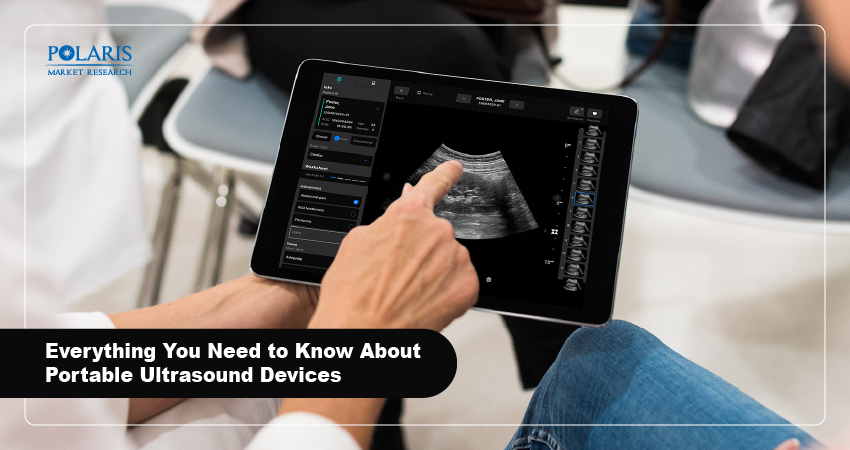Everything You Need to Know About Portable Ultrasound Devices

The medical world has experienced a major shift in the field of diagnostic imaging over the past few years. Increased computing power and advances in imaging technologies have made the ultrasound technology compact enough to fit in the healthcare provider’s coat pocket or even connect to a smartphone. This leap in connectivity and accessibility is transforming how medical conditions are diagnosed globally.
In this blog post, we take you to the fascinating realm of portable ultrasound devices. We explain to you their fundamentals, types, and different technologies used. Additionally, we cover the key stats of the portable ultrasound devices market and shed light on the key factors shaping the market landscape. Continue reading to know more!
What Are Portable Ultrasound Devices?
Ultrasound devices have undergone significantly evolution over the past few decades. The devices that were once very large and bulky have become compact. Portable ultrasound devices offer the flexibility and mobility needed by clinicians to examine patients in different areas. Also, they enable clinicians to get high-quality images without relying on a single machine. Furthermore, the smaller footprint of these devices means they can easily be moved from room to room, thereby reducing wait time and improving patient experience.
Common Types of Portable Ultrasound
Below, we’ve explained to you the most commonly used types of portable ultrasounds:
Laptop-Based Ultrasounds
These systems offer an ideal solution for environments that need advanced features in a compact form. They are typically found in critical care, anesthesia, emergency, and vascular departments. Many laptop-based systems feature advanced imaging and artificial intelligence (AI) components. These features enable the efficient capturing of diagnostic images and assist with diagnosis. Another notable feature of these systems is that they can work on battery power. This makes them an ideal imaging option for mobile emergency units.
Handheld Ultrasound Devices
Handled ultrasound devices are preferred in environments needing fast scanning and high portability. These devices are easy to use and provide high imaging quality. This makes them useful across various departments. Additionally, users with varying skill levels can use them. Handheld ultrasound systems find applications across vascular, emergency medicine, critical care, anesthesiology, and radiology.
Tablet-Based Ultrasounds
These ultrasounds can be found in tight-spaced environments. They are particularly chosen for their ease of use, accessibility, and disinfection. Tablet-based ultrasounds are used by healthcare providers across the critical care, anasthesia, and emergency departments. These devices may come with advanced features. However, they don’t make for a robust imaging solution owing to their touchscreen nature. Tablet-based systems are preferred for specific use cases, including biopsies and bedside applications.
Key Market Metrics
Our latest analysis reveals the portable ultrasound devices market to register sustained growth in the coming years. The study reveals the market to register a CAGR of 4.2% between 2025 and 2034, reaching USD 8.75 billion by 2034.
The growing shift towards point-of-care (POC) diagnostics is a key factor shaping the development of the portable ultrasound devices market. The rising prevalence of chronic conditions like diabetes and cardiovascular diseases is further fueling the need for these devices.
Portable Ultrasound Technologies Explained
Below, we’ve explained to you the commonly used ultrasound technologies in portable ultrasound devices:
2D Ultrasound
2D ultrasound is a foundational imaging technique used in ultrasound devices. It offers a cost-effective and accessible solution for various medical applications. Devices based on 2D ultrasound make use of a phased array transducer that emits ultrasound waves. The ultrasound transducer processes the returning echoes to develop a two-dimensional image. 2D ultrasound devices provide a planar view, which can be a restraining factor in the interpretation of complex spatial relationships. However, their portability and affordability make them a valuable tool in environments with limited resources.
3D and 4D Ultrasound
3D and 4D ultrasound technologies are being increasingly integrated into portable ultrasound devices. 3D ultrasound captures multiple 2D images to render a 3D image. 4D adds the element of time and allows for real-time visualization of fetal movement. Along with assessing fetal development, these technologies help identify structural anomalies and facilitate parental bonding during pregnancy. They also find applications in other areas such as vascular imaging and cardiology. Manufacturers are increasingly working on making 3D and 4D ultrasound machines more user-friendly. This, in turn, is allowing wider access to advanced imaging in various settings.
Doppler Ultrasound
Portable ultrasound devices are seeing increased integration of the Doppler ultrasound technology. It allows for the visualization of blood flow using sound waves that detect movement within blood vessels. There are various types of Doppler, including color Doppler, power Doppler, and spectral Doppler. Color Doppler displays the direction of blood flow, whereas power Doppler just shows the presence of blood flow. Spectral Doppler provides blood flow measurements in the form of a graph, making it useful for assessing vessel blockages and flow velocity.
Use of AI in Portable Ultrasound Devices
Portable ultrasound devices are undergoing a significant transformation due to the integration of artificial intelligence (AI). The ability of AI to provide real-time feedback and guidance to users helps overcome the need for highly specialized ultrasound expertise. This expands the user base to include a broader range of healthcare professionals, such as general practitioners and nurses.
AI algorithms are trained to recognize patterns and anomalies in ultrasound images with high precision. This enhances the quality of diagnoses and helps detect subtle abnormalities that might be missed otherwise. Additionally, AI's ability to automate and streamline various aspects of ultrasound workflow frees up time for healthcare providers to focus on more complex tasks and patient care.
To Conclude
In conclusion, healthcare delivery is constantly evolving. The portable ultrasound devices market is proving to be an essential diagnostic companion in diagnostic imaging. Their use helps bridge the gap between clinical assessment and traditional imaging. With proper training and integration into clinical workflows, the portable ultrasound devices have the potential to improve patient outcomes across nearly every medical specialty.

